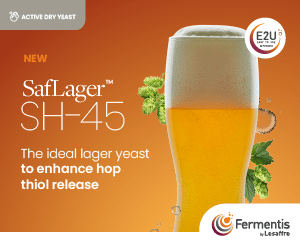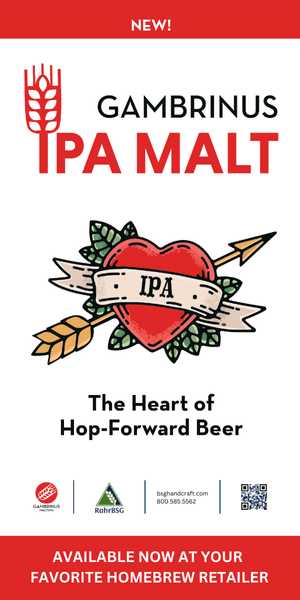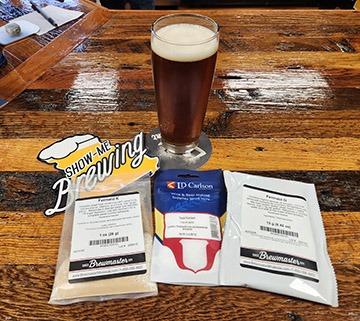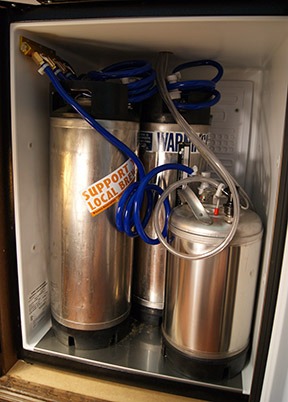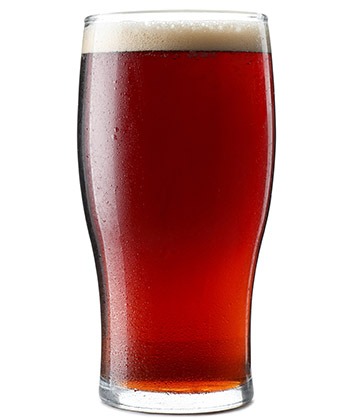Pro Am Brewing with Mr. Wizard

For several years I wanted to participate in the ProAm competition at the Great American Beer Festival (GABF), but was not sure how to go about teaming up with an award-winning homebrewer. A classified ad in the local paper or posting a sign in our brewery seemed a little desperate. Coordinating a special competition for the sole purpose of finding a teammate did not really seem to fit my idea about the best way of selecting a partner. Too much like Millionaire Matchmaker! And chatting up homebrewers in the pub seemed too much like trolling the singles scene.
Fortunately for me and my brewery, Springfield Brewing Company in Springfield, Missouri, a friend proposed a great idea. Ben Stange, a member of the Zymurgists of the Ozarks homebrewing club, better known as “ZOO,” and host of the radio show Beer Buzz Radio, made a proposition. I would participate as a judge in the upcoming Hoppy St. Patty’s Day homebrew competition and the beer that won Best of Show would be considered for a ProAm collaboration — if the beer was something that the brewing team at Springfield Brewing Company would want to brew and sell. This sounded like a great plan and the journey began!
What is the ProAm?
The ProAm Competition is a special category at the GABF. All ProAm beers begin their journey as award-winning homebrewed beers judged in an American Homebrewers Association (AHA)-sanctioned event. Somehow the brewer collaborates with a commercial brewery to brew their award-winning recipe and sell this beer as a commercial offering. Beers that fit these criteria are then eligible for entry into the ProAm category. There are some other rules that are important, for example the homebrewer cannot also be employed by a commercial brewery. The homebrewer also has to be a member of the AHA and the commercial brewery must be a member of the Brewers Association (BA). But other than these main guidelines, any beer that wins an award in an AHA-sanctioned event may find its way to the ProAm judging.
Hoppy St. Patty’s Day
It had been many years since the last time I judged in a brewing competition and I was a little nervous. Since a judge or two ended up with some last minute conflicts the panel of judges ended up with more cases on their afternoon dockets than originally planned! We each ended up judging all five categories, with over 31 beers in total.
At the end of the day we finally made it to the best of show round and one of my fellow jurists did a great job of helping the group sort through the category winners to determine the Best of Show beer along with the runner-ups. The beer we selected was an English-style pale ale brewed by a local homebrewer named Keith Wallis. So if we were going to do this thing, Keith would be our partner.
First Contact
I consulted with the brewing team at Springfield Brewing Company to make sure we were all on board with the plan. Bringing a stranger into the brewery for a collaboration brew was a little weird when we all started to think about it. What if we did not hit it off? What if Keith did not dig our beers? We started thinking that a “get to know each other meeting” should have been one of the conditions we had included in our commitment to this journey. But we had agreed to work with Keith on this project and there was no turning back. It was time to make first contact.
We pulled our team together and asked Keith to come to the brewery for a meet and greet. If we were a bit anxious about this meeting, I have to think that Keith was really anxious! It was like a really weird blind date about to happen. As it turned out, our meeting was more like an interrogation than an informal conversation. We wanted to know about Keith! What he did, where he worked, how long had he been homebrewing, what he wanted to name his beer, what his favorite beers were, what hobbies did he have outside of brewing, and on and on. At some point in the process we ran out of prying questions and adjourned to the bar for a beer. I am sure Keith was relieved when this ordeal was over.
Planning for the Big Day
Our group decided that if we were going to do this right that the brew day should be a special day and we wanted to include Keith’s homebrewing buddies from the ZOO homebrew club. We would include the group in the brew day, give a tour of our brewery, have a Q&A session, taste some beers and maybe even sneak away from the brewery for a little bit to see some big tanks being built across town by my employer, the Paul Mueller Company. Of course we also needed to scale up Keith’s recipe from a 5-gallon (19-L) batch to a 500-gallon (1,892-L) batch.
Keith used an English ale yeast in his homebrew recipe that we don’t use in our brewery, so we would need to bring in this strain and then propagate before use. Keith used floor malted Maris Otter malt, so we would need to buy some of this malt for the big day. And he also used Kent Goldings hops. This was going to be a fun day indeed!
We also wanted to create some chalk art and a T-shirt to commemorate this special brew. We knew from our initial interrogation that Keith was a jeweler by trade and our team wanted something clever. He named his beer “585 ESB” after the three-digit abbreviation that jewelers use for 14 karat gold. A fitting name for a Best of Show beer! The logo we ended up developing looked like a jeweler’s hallmark. It included a crown design because Springfield is called the Queen City, the alchemical symbol for gold and the beer’s name.
The brew day went great. Fermentation was smooth, filtration not a problem and the finished product looked and tasted great. It was especially exciting that our patrons really liked this beer and did their best to drain the tank as quickly as possible. All signs were positive for a great showing at the ProAm in Denver.
The Trip to Denver
The finale to all of this was, of course, the Great American Beer Festival. The GABF is the largest beer festival in the world. It also has more volunteers coordinating all aspects of the festival than any other event in the nation, surpassing the Rose Bowl as the leader in this metric. We went out to Denver early so we could visit some breweries before the madness began. Our road trip included visits to Odell, Funkwerks and New Belgium in Fort Collins and Prost, Breckenridge and Stranahan’s in Denver. We also took Keith to the Falling Rock on Tuesday night where we saw some high profile brewers. While we were sitting outside I saw Tomme Arthur and Vinnie Cilurzo standing a few feet behind Keith, and I said something like “Hey Keith, Tomme and Vinnie are right behind you,” and when he looked over his shoulder it was like a kid seeing something new and exciting for the very first time.
Keith’s beer was one of the featured ProAm beers during the Friday evening session and it was really exciting to see him so pumped up for the tasting. The awards ceremony for the GABF was held on Saturday morning with what looked like 2,000 people anxious to hear the fate of their beers. Although the 585 ESB team was bummed out that our entry did not win a medal, we were all very proud that we had taken the journey. Keith and the 585 ESB Team got some good feedback from the judges that made us all happy with our entry.
Next Year
After having a great experience competing with Keith, Springfield Brewing Company will participate in the GABF ProAm again in the future. We may have never participated in this great event if Ben Stange had not made the proposal, so my advice to other homebrewers and homebrew clubs who would like to participate in the ProAm competition is to approach a local brewery like the ZOO approached me. Chances are that you will be able to find a brewery looking for a ProAm collaborator — they just don’t know where to find you!

Springfield Brewing Co.’s 585 ESB clone
(5 gallons/19 L, all-grain)
OG = 1.048 FG = 1.010 IBU = 30 SRM = 12 ABV = 5%
Ingredients
- 9.25 lbs. (4.2 kg) floor malted Maris Otter pale ale malt
- 8 oz. (0.23 kg) crystal malt (60 °L)
- 5 AAU Kent Goldings hops (60 min.) (1.0 oz./28 g at 5% alpha acids)
- 5.5 AAU Cascade hops (10 min.) (1.0 oz./28 g at 5.5% alpha acids)
- 4.5 AAU Fuggle hops (5 min.) (1.0 oz./28 g at 4.5% alpha acids)
- 0.5 oz. (14 g) Cascade hops (dry hop)
- 0.5 oz. (14 g) Fuggle hops (dry hop)
- 1⁄3 tsp. Irish moss (5 min.)
- Wyeast 1945 (Neo Britannia)
Step by Step
Mill the grains and dough-in targeting a mash of around 1.5 quarts (1.4 liters) of water to 1 pound (0.45 kg) of grain (a liquor-to-grist ratio of about 3:1 by weight) and a temperature of 154 °F (68 °C). Hold the mash at 154 °F (68° C) until enzymatic conversion is complete. Sparge slowly with 170 °F (77 °C) water, collecting wort until the pre-boil kettle volume is around 6.5 gallons (25 L). The total wort boil time is 60 minutes, with hop additions at 60 minutes, 10 minutes and 5 minutes before the end of the boil. Irish moss is added with the third hop addition. Chill the wort to 65 °F (18 °C) and aerate thoroughly. Pitch wort with 2 qts. (2 L) of starter to provide a pitching rate of about 10 million cells per mL and ferment at 65 °F (18 °C). After fermentation is complete add dry hop additions and hold beer for seven days for a combination diacetyl rest and dry hop rest period. Rack beer to bottling bucket and carbonate the beer to approximately 2.5 volumes.

